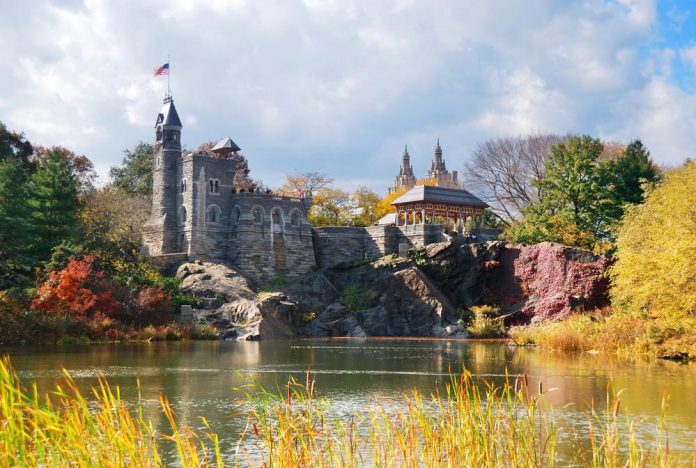The United States, a country renowned for its modern skyscrapers and technological advancements, also houses an array of enchanting castles. These castles, reminiscent of medieval architecture, offer a glimpse into a past where knights, nobles, and perhaps dragons roamed. These architectural marvels stand as a testament to the country’s diverse history and cultural richness, inviting visitors to explore their grand halls, secret passageways, and lush gardens.
Table of Contents
Brief History of Castles in the USA
The fascination with castles in the United States is a unique aspect of American architectural history, blending the nation’s innovative spirit with a nostalgia for the ancient, romantic past of Europe.
Unlike the castles of Europe, steeped in centuries of history and often built for strategic defense, American castles emerged from a different context, reflecting a blend of admiration, wealth, and imagination.
The Inspiration Behind American Castles
In the 19th and 20th centuries, as the United States experienced rapid industrial growth and wealth accumulation, the country’s newly rich sought ways to manifest their newfound status.
Inspired by European travels and tales of old-world grandeur, American magnates began constructing residences that mirrored the castles of the European aristocracy.
These structures were expressions of personal taste, architectural experimentation, and a desire to connect with historical prestige.
Architectural Styles and Influences
American castles showcase a rich diversity of architectural styles, borrowing elements from Gothic, Romanesque, Renaissance, and other European traditions.
Architects like Frederick Law Olmsted and Calvert Vaux, inspired by these styles, created iconic structures such as Belvedere Castle in New York City’s Central Park, a fine example of Gothic and Romanesque Revival architecture.
Some areas in the U. S., like New Jersey, are especially famous for their castles. These castles were not bound by the need for defense but were instead designed to awe and inspire, often incorporating modern innovations and conveniences that their medieval counterparts could never have imagined.
From Private Residences to Public Treasures
Many of these grand edifices initially served as private estates for the elite, such as the Biltmore Estate in North Carolina, which remains the largest privately-owned home in the U.S.
Over time, however, a number of these castles have transitioned from private residences to public spaces, serving as museums, hotels, and venues for events, thus allowing the broader public to explore and appreciate their grandeur and historical significance.
The Role of Castles Today
Today, American castles are cherished landmarks that offer a glimpse into a unique period of architectural history.
They serve as a reminder of the country’s rapid transformation and the ambitious, often eccentric, visions of its wealthiest citizens.
Far from the turbulent histories of their European inspirations, American castles stand as monuments to creativity, wealth, and the timeless appeal of the castle as a symbol of nobility and fantasy.
In visiting these castles, tourists and architecture enthusiasts alike are offered a journey not only through the history of architecture but also through the personal histories of those who dreamt them into existence. Each castle tells a story of ambition, reflecting a period when America was forging its identity, looking to the past to build the foundations of its future.
This unique blend of historical admiration and architectural innovation underscores the enduring appeal of castles in the United States, turning them into beloved historical sites that continue to draw visitors from around the world.
Our List of The Best Castles to Visit in the United States
1. Hammond Castle, Gloucester, Massachusetts
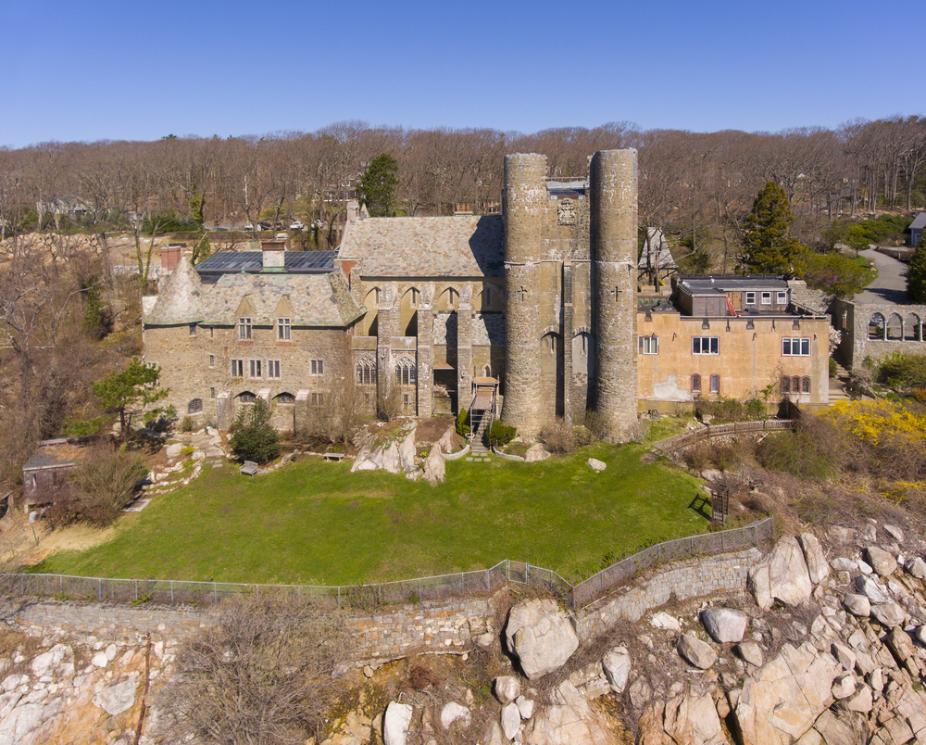
Hammond Castle is the brainchild of John Hays Hammond Jr., a prolific inventor known as the “Father of Remote Control.” This castle served as his residence and laboratory, where he devised over 400 patents. Constructed to mimic the medieval style, it also showcases a mix of architectural elements from various periods.
Nestled on the Atlantic coast in Gloucester, Massachusetts, construction of the castle spanned from 1926 to 1929.
The castle integrates modern and various historical styles, including 15th to 18th-century elements, creating a unique blend that overlooks Gloucester Harbor.
Now operating as the Hammond Castle Museum, it displays an extensive collection of Roman, medieval, and Renaissance artifacts, along with exhibits dedicated to Hammond’s life and inventions. Visitors can explore living areas, courtyards, towers, and the Great Hall through self-guided tours. Special events and private functions often grace its lawns.
2. Gillette Castle, Haddam, Connecticut
Gillette Castle was the eccentric home of William Gillette, an acclaimed actor best known for his portrayal of Sherlock Holmes. His unique architectural vision led to the creation of this castle, which stands as a testament to his creative genius.
Perched high on a hill overlooking the Connecticut River in East Haddam, Connecticut, the castle’s construction took place between 1914 and 1919.
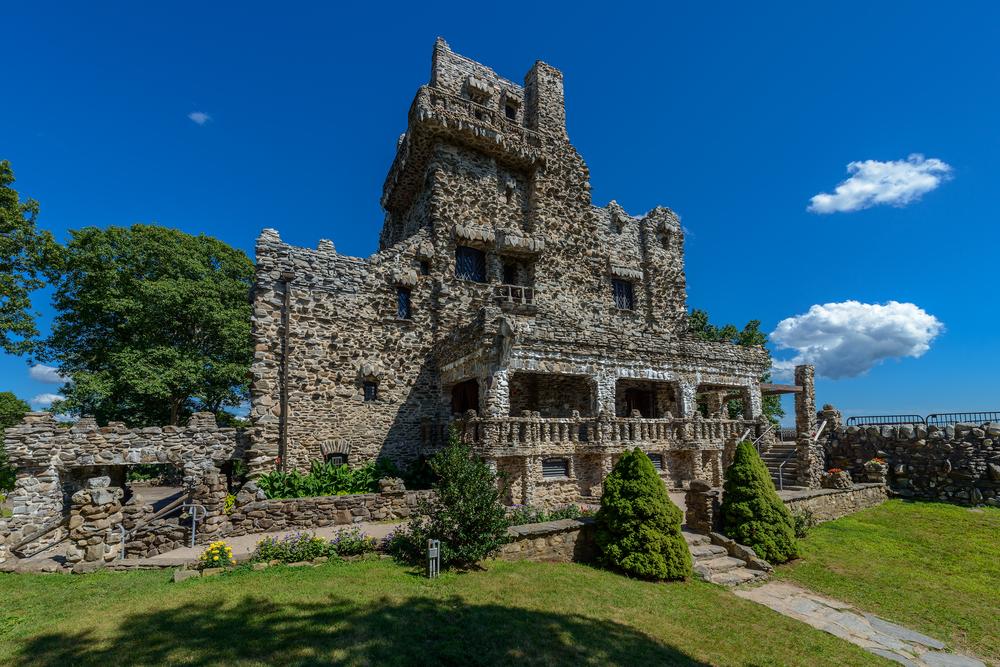
Reflecting a medieval motif, the castle’s design is whimsical yet fortified, with a unique blend of wooden features that distinguish it from traditional stone castles.
Now a state park, Gillette Castle offers tours showcasing Gillette’s inventive design elements, including unusual door mechanisms and carved wooden light switches. The estate also features hiking trails and picnic areas for visitors to enjoy.
3. Oheka Castle, Huntington, New York
Oheka Castle embodies the luxurious spirit of the Gilded Age, built by financier Otto Hermann Kahn. This opulent estate, second in size only to the Biltmore, was intended as a summer retreat and a venue for lavish entertainment.
Situated in Huntington, New York, the castle was completed in 1919, marking the culmination of a grand project that reflected Kahn’s immense wealth and taste for the extravagant.
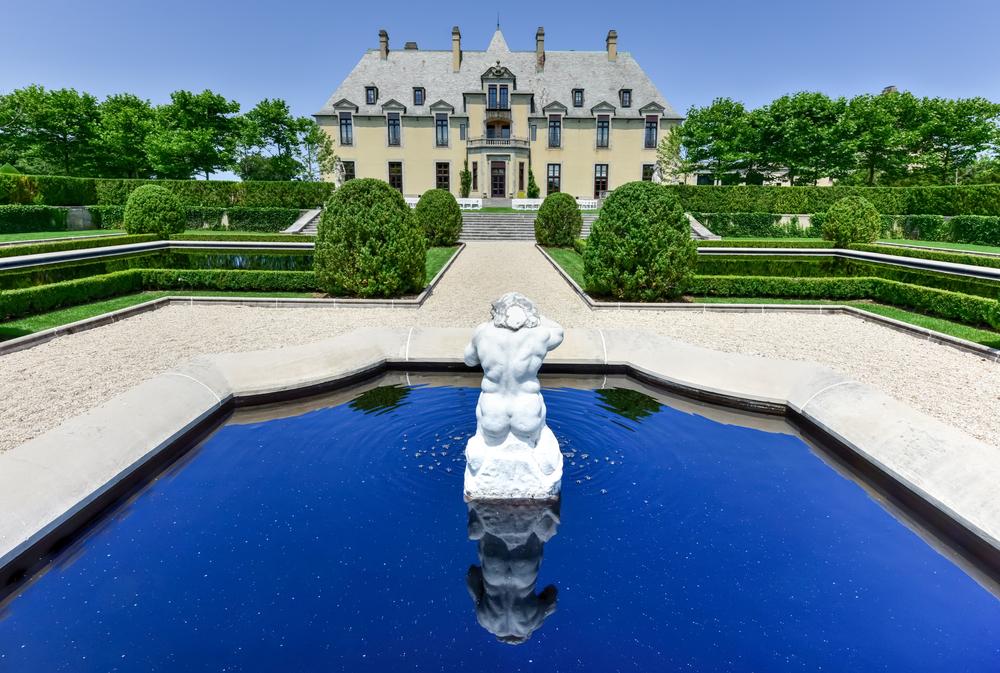
Drawing inspiration from French chateaus, Oheka’s architecture features classic elements of the French Renaissance, including intricate designs and expansive, manicured gardens.
Today, Oheka Castle functions as a luxury hotel, event space, and historic tour site, offering visitors a glimpse into its storied past and the opulent lifestyle of its original inhabitants. Tours are available for those wishing to explore its history, gardens, and beautifully restored rooms.
4. Iolani Palace, Honolulu, Hawaii
Iolani Palace holds a unique position in American history as the only royal palace in the United States used as an official residence by a reigning monarch. It was the home of the Hawaiian Kingdom’s last two monarchs, King Kalakaua, who commissioned its construction, and his sister and successor, Queen Liliuokalani.
Located in the heart of Honolulu, Hawaii, Iolani Palace was completed in 1882, showcasing a remarkable example of the American Florentine architectural style.
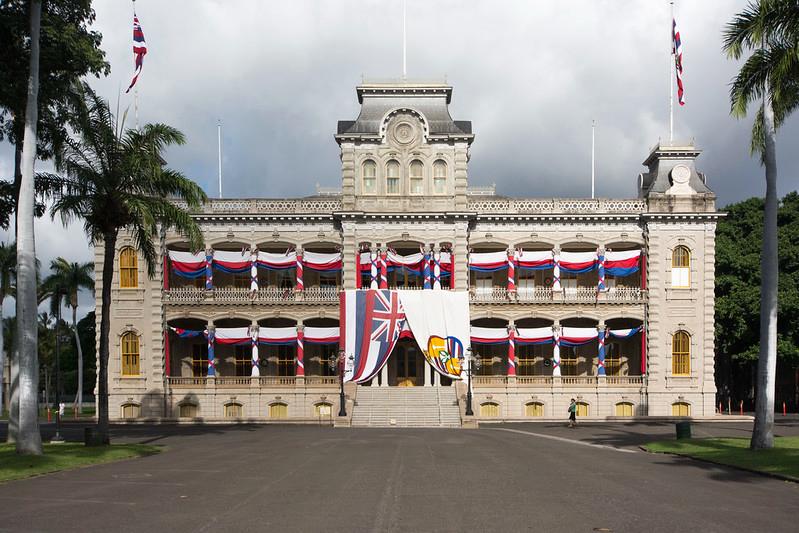
The palace’s architecture is classified as American Florentine, a unique blend of Italian Renaissance and native Hawaiian architectural elements, making it a standout landmark in Honolulu.
Iolani Palace is open to the public for guided tours, offering insights into the royal heritage of Hawaii and the palace’s pivotal role in American and Hawaiian history. The tours provide a deep dive into the cultural and political significance of the palace, featuring original royal furnishings and artifacts.
5. Biltmore Estate, Asheville, North Carolina
Biltmore Estate is the grandiose project of George Washington Vanderbilt II, embodying the opulence of the Gilded Age. It stands as the largest privately-owned home in the United States, a testament to the Vanderbilt family’s wealth and social standing.
Nestled in the scenic Blue Ridge Mountains of Asheville, North Carolina, the construction of Biltmore Estate was completed in 1895.
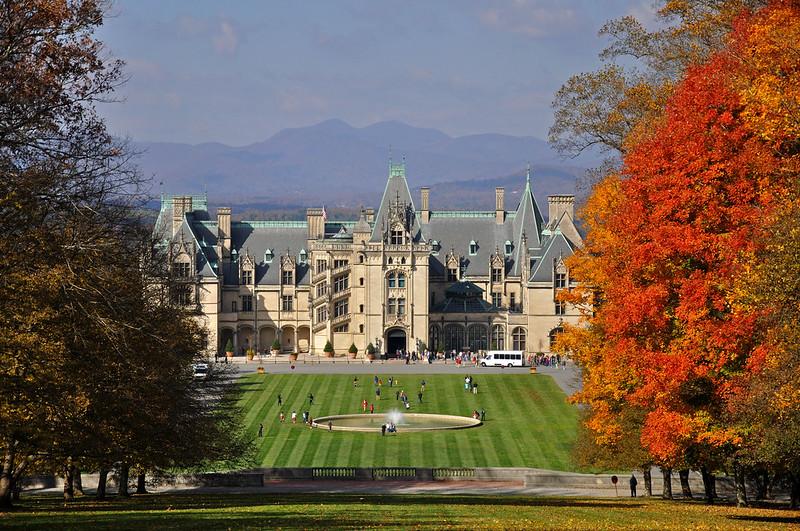
The estate is designed in the Châteauesque style, inspired by French Renaissance chateaus, and features a staggering 250 rooms, including 35 bedrooms and 43 bathrooms.
Today, the Biltmore Estate welcomes visitors to explore its vast 8,000-acre compound, which includes the mansion itself, beautifully landscaped gardens, a winery, and various seasonal events. Guided tours offer an in-depth look at the lavish interiors and the estate’s history.
6. Belvedere Castle, New York
Belvedere Castle serves as a whimsical folly within Central Park, New York. Designed by Calvert Vaux and Frederick Law Olmsted, the castle was initially intended as a Victorian-era lookout to Central Park’s scenic vistas and has since become an iconic landmark.
Situated in the heart of Central Park, New York, Belvedere Castle was constructed in 1869, offering park goers breathtaking views of the surrounding landscapes.
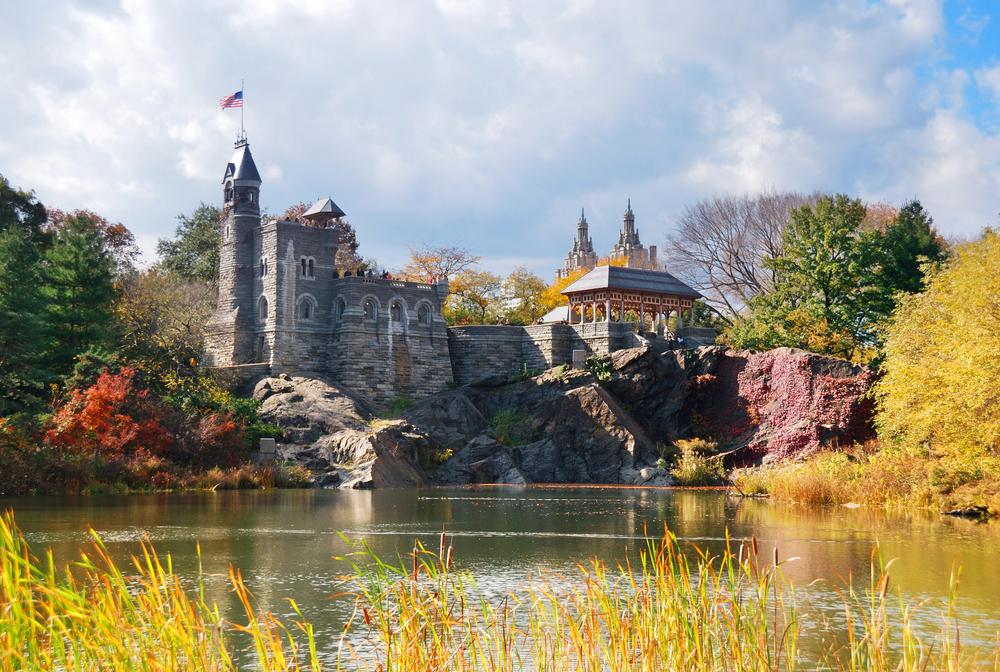
The castle features a mix of Gothic and Romanesque Revival architectural styles, adding a fairytale-like charm to Central Park’s natural beauty.
The castle functions as a visitor center and includes exhibit rooms and an observation deck, which provides panoramic views of the park and the city skyline. Educational programs and guided tours are available to visitors, offering insights into the castle’s history and Central Park’s ecosystem.
7. Montezuma Castle, Arizona
Montezuma Castle stands as a towering testament to the ingenuity and architectural prowess of the Sinagua people, an ancient Native American civilization. This cliff dwelling, nestled in a limestone alcove, highlights the adaptability and resourcefulness of its builders.
Located near Camp Verde, Arizona, Montezuma Castle was constructed between 1100 and 1425 AD, making it one of the best-preserved cliff dwellings in North America.
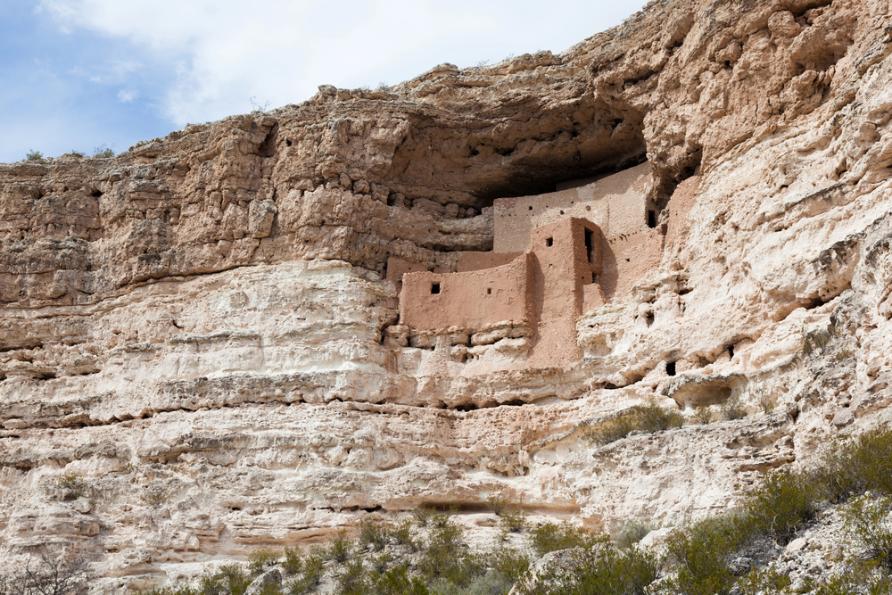
The structure is emblematic of Native American cliff dwelling architecture, ingeniously built into the natural alcove to provide protection and sustainability.
Today, Montezuma Castle is a National Monument, accessible to the public through viewing platforms that offer a glimpse into the lives of the early inhabitants. The site provides educational resources and interpretive programs detailing the historical and cultural significance of the dwelling and the Sinagua people.
Takeaway
Venturing through these historical landmarks across the nation, visitors are invited into a world where architectural splendor meets the echoes of history.
Each structure, with its unique origin and design, narrates a chapter of the diverse American saga, from the ambition of the country’s early innovators to the cultural legacies of its indigenous peoples.
These edifices are not merely relics of the past but vibrant hubs of education and inspiration, offering a bridge to bygone eras.
Walking their grounds, one is transported across time, connecting with the visions and dreams that shaped them, and leaving with a richer understanding of the multifaceted story of America.

